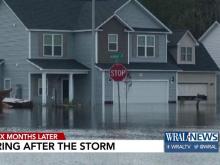- One set of evacuation orders lifted in Caldwell County after wildfire contained
- 'We gutted every building' | Chimney Rock rebuilding after Hurricane Helene
- 'We gutted every building' | Chimney Rock rebuilding after Hurricane Helene
- Debris from Hurricane Helene provides fuel, complicates containment for spring wildfires
- David & Nicole Tepper increase Hurricane Helene relief commitment to $750k
As floods keep coming, cities pay residents to move

Nashville, Tenn. — Jonna Laidlaw was terrorized by rain. Her house, with its lovely screened-in back porch, had flooded some 20 times since 2001, from a few inches to 6 feet. She and her husband would do their repairs with help from their flood insurance, but before long it would flood again.
“Every time it sprinkled, I got terrified,” she said.
When city officials offered to buy the house last year, she and her husband gladly said yes. They have since moved to higher ground.
Nashville is trying to move people like the Laidlaws away from flood-prone areas. The voluntary program uses a combination of federal, state and local funds to offer market value for their homes. If the owners accept the offer, they move out, the city razes the house and prohibits future development. The acquired land becomes an absorbent creekside buffer, much of it serving as parks with playgrounds and walking paths.
Climate change is increasing the program’s urgency. While a number of cities around the country have similar relocation projects to address increased flooding, disaster mitigation experts consider Nashville’s a model that other communities would be wise to learn from: The United States spends far more on helping people rebuild after disasters than preventing problems.
David Maurstad, who heads the National Flood Insurance Program, said buyouts were the most permanent way to mitigate against future flood hazards. “Rebuilding out of harm’s way can help avoid future devastation in a way that flood insurance cannot,” he said.
Flooding is a complex phenomenon with many causes, including land development and ground conditions. Climate change, which is already causing heavier rainfall in many storms, is an important part of the mix. Warmer atmosphere holds, and releases, more water.
“We’re starting to see evidence that the number of extreme events will increase,” said Barbara Mayes Boustead, a climate scientist and an author of the latest installment of the National Climate Assessment, a report written by 13 federal agencies that explores both the current and future impacts of climate change. An area’s average annual rainfall might increase by what seems to be a relatively small amount — from 40 inches a year to 42, for example — and “in your head, you might say ‘big whoop,’ ” she said. “But how it falls is the critical piece of the story,” with the extra amount concentrated in extreme events.
And while Nashville hasn’t seen the kind of repeated, extreme flooding that a city like Houston has, the effect is being felt, said G. Dodd Galbreath, the founding director of Lipscomb University’s Institute for Sustainable Practice and a member of the city’s stormwater management committee. “It’s a new weather pattern,” he said. “You can no longer rely on statistical reliability and statistical measurement as your sole measurements of risk.”
The costs of flooding continue to climb, but only 20% of the money that the Federal Emergency Management Agency distributes in disaster grants is earmarked for pre-disaster work, even though research shows that a dollar spent on mitigation before a disaster strikes results in at least $6 in savings.
There are many reasons more people end up rebuilding in place than moving away. Reimbursement is relatively quick, while FEMA’s buyout programs tend to be slow and difficult to navigate. “A lot of people give up midway through the process,” said Craig Fugate, a former FEMA head.
Around the nation, relocations are showing results. Despite this year’s floods that inundated many communities in Nebraska and the upper Midwest, in Beatrice, Nebraska, the waters filled a park that included 40 acres of cleared lots and no homes or businesses in town were damaged. FEMA has estimated the town’s program prevented $13 million in damage in 2015 alone. “People got tired of rebuilding all the time,” said Tobias J. Tempelmeyer, the city administrator.
Paul Osman, the chief of statewide floodplain programs for the Illinois office of water resources, said his state’s program, which has bought some 6,000 structures and properties, made all the difference in this year’s floods. Instead of working out of an emergency operations center, dealing with sandbagging, community shelters, debris cleanup, policing and more, he said, “It’s a nonevent.”
How did Nashville create its own successful program? The city had gained some experience even before the 2010 flood, which caused $2 billion in damage. Starting in 1998, it bought 93 homes in hazardous areas, which helped city officials navigate the complex jumble of programs involved.
They understood that the FEMA programs didn’t put money up front, and that the federal government will reimburse 75% of the money in most cases, with the rest split between state and local sources. That meant the city ultimately spends $12,500 of its money for every $100,000 it uses to buy a house. It has used this leverage to build funding, bit by bit, to buy more than 400 homes and vacant lots, spending more than $43 million in total so far. If people don’t sell after a flood, they are likelier to sell after the next one, said Tom Palko, assistant director of the city’s stormwater division. “You have to be patient,” he said, “not go in guns blazing and say, ‘we’re going to solve everybody’s problems! We’re going to save the world!’ ”
One topic officials do not bring up in the public meetings about buyouts: the possible role of global warming. “I don’t want to get to a public meeting and debate climate change,” Palko said. Instead, they cite the numbers: “We have had four of these events in 10 years, when in the past 25 years there may have been only one of those events of that magnitude.”
Laidlaw said she was pleased with the program, and with canceling flood insurance that had climbed from $300 a year to $700 each month. When they first bought the house, “they were talking like 500-year floodplain — what chance was there that we’d be there in 500 years? But it happened.” (“500-year floodplain” is shorthand for a 0.2% chance of flooding in any given year.)
“The idea of not having to clean, not having to show the house” was also attractive. Laidlaw said. And besides, “I didn’t really think with the flood history we’d be able to sell it.” She said she still gets anxious when it rains, but “I can calm down pretty well now.”
Faye Sesler is another happy seller. Sesler, a real estate agent, had the idea to purchase a home in 2012 as a rental unit. She and her husband soon discovered that the lovely creek behind the house could end up in the house. And while her husband, a contractor, could handle repairs, neither of them was happy about it.
“My husband, every time it rained, he’d say, ‘You better hope it won’t flood.’ ” The city’s program, she said, “was a marriage saver.”
They sold in 2016 after attending a community meeting, where “I was amazed that so many people didn’t want to sell. What I wanted to do was get them and shake them and say ‘listen to this — it’s going to flood again.’ ”
Carol Mayes has tried to stay. She moved back to Nashville from Washington, D.C., in 2008 to take care of her mother, who died four years later. She now lives in her home, which flooded in 2010. She refused the city’s offer, but many neighbors took it.
Osman, the Illinois floodplain manager, said it could also be hard to get older people to accept buyouts, as well as people in poorer neighborhoods. “Nobody wants to start a mortgage again when they’re retired,” Osman said. In poorer Illinois communities, fair market value for a home might turn out to be just $10,000, and “you can’t buy a mobile home for that,” he said. “It’s a struggle, and I don’t have a good answer.” Nicholas Pinter, the associate director of the center for watershed sciences at the University of California, Davis, said the challenges to “overcoming social inertia” are so high because of “the intense sense of place that people have.”
Still, even though moving people can be expensive and contentious, he said, “it looks like we’re going to have to look at a lot more flood relocations in the future.”



